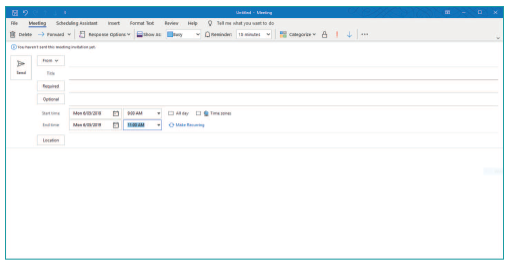Introduction
Topic 4: Facilitating meetings will take you through everything you need to know and apply when facilitating meetings.
This starts with an explanation of the function of meetings and initial considerations. The steps needed to facilitate a meeting, including preparation, execution and following on actions are then outlined.
Elements for developing and delivering quality presentations is also included in this final topic for this module.
Meetings
Alone we can do so little; together we can do so much.Helen Keller
A meeting is a structured gathering of individuals within an organisation or between different organisations, convened to discuss specific topics, make decisions, share information, collaborate on projects, or address issues that require collective input. Meetings can take various forms, including face-to-face interactions, virtual conferences, or teleconferences, and they serve as a crucial communication tool in workplaces.
Key aspects of meetings in the workplace:
- Purpose: Meetings have a clear objective, whether it's problem-solving, decision-making, brainstorming, project updates, or team building.
- Participants: Meetings involve participants who have a stake in the topics being discussed. These participants can include employees, managers, stakeholders, clients, or external partners.
- Agenda: A well-defined agenda outlines the topics to be covered, the goals of the meeting, and the allotted time for each agenda item. It serves as a guide to keep discussions focused and on track.
- Facilitation: Meetings are typically facilitated by a designated person, often a manager or team leader, who ensures that the agenda is followed, encourages participation, and maintains order.
- Interaction: Participants are encouraged to engage actively, share their perspectives, ask questions, and provide input. Meetings often involve discussions, presentations, Q&A sessions, and collaborative activities.
- Decision-Making: Meetings provide a platform for making decisions, whether by reaching a consensus, voting, or deferring decisions to a later date pending additional information.
- Follow-Up: Meetings usually conclude with a summary of key points discussed, action items, and responsibilities assigned to specific individuals. Follow-up actions are crucial to ensure that decisions made during the meeting are implemented.
- Documentation: Meeting minutes or notes are often taken to record discussions, decisions made, and action items. These documents serve as references for future meetings and provide accountability for follow-up tasks.
Effective meetings contribute to improved communication, collaboration, and decision-making within organisations. They offer a forum for idea exchange, problem-solving, and strategic planning, fostering a productive and cohesive professional environment.
Planning a meeting
There are several elements to be considered before you schedule a meeting. These include:
- The purpose or objectives you hope to achieve
- The participants needed to make that happen
- The type of meeting that suits the goals and participants
- Meeting logistics (i.e. time, date, venue, platform, accessibility etc.)
There are other factors you may consider at this stage, however these are the core elements to be addressed at the start of your planning process. The remaining considerations relating to meeting content and structure will be addressed when preparing for your meeting (see below).
Purpose and objectives
Be clear about the purpose of the meeting. Consider the specific goals or outcomes you are after and how they may be achieved.
The importance and impact of these goals will guide many of the following meeting planning considerations.
As part of this element, consider if you do indeed need a meeting, or if you can address what you need or resolve your issue more simply through research, an email or a quick conversation.
Participants
Who to invite?
Identify the key stakeholders and participants who need to attend the meeting.
Meeting participants could be a range of different people, such as:
- Management
- Peers and/or colleagues
- Clients and/or clients representatives
- Partner organisations
- Competitors etc
Regardless of the role or relationship of an individual you should target your invitees based on the roles needed from the 3 key contributions identified:
- Decision makers: These are the people who can approve plans or changes on behalf of the organisation, stakeholder or client.
- Subject matter experts: These are the people who know everything that needs to be understood and considered.
- Implementors: These are the people who may be responsible for actioning any meeting outcomes as agreed.
How many to invite?
The number of meeting attendees should be adapted to the purpose of the meeting. Where you are looking to collect ideas and brainstorm opportunities, you may choose to invite a large group of people with a range of perspectives and skill levels. If you are looking to discuss a sensitive or substantial change, you may be better placed to keep the gathering smaller so you can keep the conversation confidential or focused.
Type of Meetings
There are two main types of meetings:
- Formal meetings
- Informal meetings
Formal Meetings
Formal meetings are held where a specific topic or topics are required to be discussed. They generally involve presentation of workplace information or progress on projects, performance or achievement of targets. These meetings may include external stakeholders, senior management and department managers. Alternatively, a department may hold its own formal meetings to present and discuss information that is irrelevant to other departments.
Formal meetings require planning and organising. To organise or facilitate a formal meeting you will need to plan:
- time
- date
- location
- attendees
- resources.
Depending on the size of the workplace, its meeting procedures and the number of attendees, this might be as simple as sending a recurring meeting invitation through email or the intranet and booking a meeting room. On the other hand, formal invites may need to be sent to parties external to the workplace and senior management. Some meetings may be held at an external location, which requires booking a conference room and may include organising refreshments if the meeting is run over many hours.
Informal Meetings
Informal meetings can be between two or more people.
As mentioned above, these meetings may occur on an ad-hoc basis or may happen regularly. They do not require agendas or minutes, but may require some form of documentation or note taking. For example, a weekly catch up with your supervisor to run through the week ahead may require you to take notes on what you need to do, but you do not need to write minutes. Informal meetings are often called to address emerging issues, changes that may impact the week ahead, department or team announcements or to run training sessions.
Meeting logistics
Meeting logistics include many areas for consideration, such as the meeting time and date, the venue or platform, location and participant accessibility considerations etc.
- Time and date
- Choose a suitable date and time for the meeting, considering participants' schedules and time zones.
- Be mindful of the meeting's duration; keep it as short as possible while ensuring all agenda items are covered.
- Venue or platform
- Meeting may be hosted in person and on-site or remotely using a virtual platform.
- When planning a location based meeting, consider the logistics of your participants coming together, the location, the venue facilities etc.
- Where it is too hard to pull those needed to the one location you may revert to a virtual platform. When choosing a platform you must ensure it is accessible and user-friendly for all participants.
- Accessibility considerations
All participant needs must be considered when planning a meeting, especially when you are meeting with people for whom English is a second language, or those living with a disability relating to hearing, communicating or mobility. You should always consider the following:- whether an interpreter is required
- if there is enough space in the meeting venue for wheelchairs or other mobility/ assistance devices
- if the meeting venue is accessible for those with wheelchairs and other mobility devices
- whether information can be translated into other languages
- whether assistive technology is required, such as software and apps that translate text to speech such as SayIt! or My Talk Tool Mobile or Hear You Now.
These 4 factors inform the basis of your meeting, so once you have them established it is time to prepare for your meeting.

Meeting preparation
Success depends upon previous preparation, and without such preparation there is sure to be failure.Confucius
Have you ever been to a meeting where it was disorganised and time was wasted trying to get equipment to work or locating the required information?
Ahead of your meeting, make sure you have:
- given yourself enough time to prepare and set up the meeting room
- checked that computers/laptops are fully charged and you have the charger on hand
- checked that there is reliable Internet access and it will be fast enough for your needs
- access to all the files you need
- enough handouts or hard copies of materials for attendees
- access to the meeting room/location (check that you have the keys if the room is usually locked when not in use, and that the location hasn’t been double booked)
- attendees will have enough space and there are enough seats/spaces at the table.
- refreshments available if the meeting is to run for several hours or for the entire day.
Preparing an Agenda
An agenda provides attendees with a list of topics to be discussed. The topics will be listed in running order (from start to end) and indicate how much time is allocated to each topic.
A basic agenda will include the following:
- Outline the purpose or primary goal of the meeting – what is the key objective/s of the meeting
- Identify meeting participants – determine who is invited to the meeting and their role/s such as chairperson, timekeeper, minute taker etc.
- Meeting logistics – this includes the time, date, duration, location or format of the meeting etc.
- Identify any input requirements from participants – this allows them to prepare for the session or reply in advance where appropriate
- Identify all agenda items – the topics and/or questions to be addressed
- Allocate a lead for each agenda item – they are responsible for hosting discussion around this element of the meeting
- Allocate realistic timeframes for each agenda item
- Time for a recap
When writing an agenda, assign realistic timeframes for each item. If you don’t, you will find that the meeting could run late because there wasn’t enough time dedicated to each topic, people ran over time or someone dominated discussion and did not allow the meeting to move forward as scheduled.
Setting timeframes allows the chair to move the meeting along without causing offence to any participants who may be holding it up (intentionally or unintentionally!).
Agenda template
Attached above is an example of an agenda that may be used to plan and track meetings in the workplace.
Circulating the Agenda
The agenda should be circulated to all invitees as early as possible. This may be included as part of the meeting invitation, or it may be circulated a little later where it is not available at the time.
This should go to all attendees well in advance of the meeting and include any attachments, additional reading or details of specific input requirements expected from participants so that they may prepare ahead of the session.
The most effective method of circulating an agenda is via email. Most email programs have a function where you can create meeting invites, add multiple attendees, set a location and time and attach your agenda and other meeting documentation.
The meeting is then added to the program’s calendar once the invite has been accepted. The person who creates the invite can also reschedule, update or cancel it. The screenshot below shows a blank meeting invitation in Microsoft Outlook.

Some workplaces will have written procedures that provide instructions on how to send meeting agendas or create meeting invitations.
In some circumstances you may be dealing with individuals that do not have access to electronic calendars. If this is the case you should contact them via phone or in person to invite them to the session and provide them with a hard copy of the agenda.
If you are meeting with people with additional considerations, you should confirm requirements with them ahead of time. This may involve including a support person to assist them in getting to the meeting, access to ramps or lifts to access meeting rooms or the inclusion of an interpreter to support communication.
Preparing for remote meetings
As mentioned above, many agencies use online meetings. This is extremely helpful when attendees are scattered across the state or country (or even overseas) and meeting in person is not cost effective, time effective or viable.
There are many applications available for remote meetings. Some common applications include Zoom, Skype for Business, GoToMeeting, Hangouts and join me. Most applications have options to choose video calling or phone calling, and to share screens and record the meeting.
As with any technology, there can be problems with using web-based or VOIP platforms for meetings. They can create opportunities for miscommunication and misunderstanding. Drop outs, freezes and lags can create frustration and waste valuable time if people are constantly having to repeat themselves, are talking over each other, or programs and connections have to be re-established.
If you are considering using an online meeting, make sure that everyone has access to good bandwidth, speed and a reliable Internet provider. Sometimes it is easier for people with slow connections to use the phone call feature rather than the video call feature (that is, the program turns off the video functionality and uses voice only). Otherwise, the old-fashioned telephone conference call may be required!
When holding an online meeting, remind attendees to find a quiet and private place in which to connect. The reason for this is to ensure that attendees are not distracted by things around them. With many of today’s workplaces implementing work-from-home days, online meetings can be ripe for distractions and interference.
For example:
- pets (for example, jumping in front of the screen, making noise)
- children (for example, arguing or fighting with each other, coming in to see what is going on, calling out for something)
- traffic, garden equipment or other external noise (for example, building works, lawn mowers, neighbours making noise, cars revving in the street)
- someone knocking on the front door (for example, visitors, door-to-door salespeople, tradespersons).
While amusing in the first instance, these types of distractions can quickly become frustrating for other attendees and may be embarrassing for the person at home if they are unable to control the interference.
Remember though, the workplace itself is not immune to distractions and interference (i.e. people talking loudly nearby, phones ringing, people walking passed doorways, colleagues interrupting etc.) so try to be patient.

Opening your meeting
At the start of any formal meeting or event in Australia it is customary to open with an acknowledgement of country.
An “Acknowledgment of Country” or “Welcome to Country” is a statement or ceremony performed at the beginning of a meeting or gathering to recognise and honour the traditional Indigenous custodians of the land on which the event takes place. This practice is increasingly common in various countries, including Australia, Canada, the United States, and New Zealand, as a gesture of respect, reconciliation, and acknowledgment of the historical and ongoing connection of Indigenous peoples to their lands.
Acknowledgment of Country
The Acknowledgment of Country is a meaningful and respectful gesture that recognises the traditional custodians of the land on which a meeting or gathering takes place. It serves to honour the Indigenous peoples' enduring connection to the land, water, and community. This acknowledgment is a step towards reconciliation, promoting awareness of Indigenous cultures, histories, and contributions. It is a way to demonstrate respect, foster understanding, and promote inclusivity.
The content of an acknowledgment may vary, but it generally includes:
- Recognition of the specific Indigenous nation(s) or tribe(s) that traditionally inhabited the land.
- Acknowledgment of their enduring connection to the land, waterways, and culture.
- Expression of gratitude for the opportunity to gather on their traditional territory.
Suggested wording for an Acknowledgement of Country may include:
I acknowledge the *___________________people, the Aboriginal/Torres Strait Islander** Owners of the land where we gather today and pay my respects to Elders past, present and emerging. I recognise their connection to Country and their role in caring for and maintaining Country over thousands of years. May their strength and wisdom be with us today.*If known add the Traditional Owners’ clan/language group name **Use ‘Aboriginal’ or ‘Torres Strait Islander’ as appropriate
Welcome to Country
A Welcome to Country extends the acknowledgment by inviting participants to not only recognise the Indigenous peoples but also to actively welcome and appreciate their presence. It is an inclusive invitation for all attendees to engage with the land and its cultural significance. A welcome emphasises the importance of shared spaces and encourages unity, mutual respect, and collaboration between Indigenous and non-Indigenous peoples.
The content of a welcome may vary, but it generally includes:
- Invitation for everyone present to actively engage and learn from the Indigenous cultures, traditions, and knowledge.
- Encouragement to participate respectfully and with an open mind, appreciating the diversity of Indigenous perspectives.
- Emphasis on unity, inclusivity, and fostering a sense of community among all attendees, both Indigenous and non-Indigenous.
The acknowledgment and welcome ceremonies are an important step toward reconciliation, promoting awareness of Indigenous history and culture, and creating an inclusive and respectful atmosphere for all participants. The wording and structure of the acknowledgment and welcome can vary based on the cultural context and the specific Indigenous peoples whose land the event is taking place on. It is crucial to consult with local Indigenous communities or cultural advisors to ensure that the acknowledgment and welcome are accurate, respectful, and culturally appropriate.
ADDITIONAL RESOURCE:
Acknowledgement of Country and Welcome to Country
For more information on these protocols, read the information found on the Reconciliation Australia website.
Running a meeting
There are four key steps to running a meeting. These include:
- Active participation:
- Stay on topic: During discussions, ensure your contributions are relevant to the agenda items. Avoid going off-topic, as it can derail the meeting.
- Speak concisely: Express your points clearly and succinctly. Avoid lengthy explanations that could extend the discussion unnecessarily.
- Contribute constructively:
- Ask questions: Seek clarification when needed and ask insightful questions related to the agenda items. This demonstrates engagement and understanding.
- Offer solutions: If there are challenges being discussed, propose potential solutions or strategies that align with the meeting objectives.
- Follow meeting etiquette:
- Respect speaking turns: Avoid interrupting others when they are speaking. Wait for an appropriate pause to add your input.
- Active listening: Pay close attention to others' contributions. This not only shows respect but also helps you build on their points constructively.
- Track action items:
- Note action items: If action items are assigned during the meeting, take note of your responsibilities and deadlines. Be clear about what is expected of you.
- Clarify ambiguities: If any action items or objectives are unclear, seek clarification before the meeting concludes to ensure you have a clear understanding of your role.
Encouraging participation
Great things in business are never done by one person. They're done by a team of people.Steve Jobs
There are several elements for consideration when encouraging participants to actively involve themselves in meetings. A major consideration is the group dynamics of those involved in the meeting.
Once you understand the impact of group dynamics, you should consider different opportunities to encourage contribution and active involvement.
Group dynamics
When you bring people together for meetings, some may already know each other, while in some cases it might be the first time some participants are met. Managing the dynamics of any group ensures that goals are achieved, and outcomes reached.
The dynamics of a group depend on the personalities of the people in it. Some people naturally suit or fall into certain group roles, which can be classified as:
- task/ work roles
- maintenance roles
- blocking roles.
Each of these roles are further explained below.
The people who fit into these roles are task focused and want to move the group towards accomplishing its goals. Listed below are a number of common types:
- The initiator/contributor: this person is great at coming up with new ideas and suggestions for improvement or change. They are generally the person who identifies the goals and the tasks required to achieve them.
- The informer: this person is the one who does the research to locate facts, statistics, and data to help the group meet its goals.
- The clarifier: this person will consider the ideas (generally brought forward by the initiator) and clarify any concerns or issues. You could consider this role as the person who looks at the suggestions and ideas to determine how they will work if implemented.
- The summariser: this person will summarise the information brought forward by the previous parties and/or summarise group progress as a whole. They are the person who makes sure everyone understands what is happening and what is to happen in future.
- The reality tester: this person is the one who sets the standards for what the group is trying to achieve. They will be ensuring that the work completed or outcomes are of the expected quality/standard.
The people who fit into these roles are concerned with ensuring the social/emotional needs of others are met, to improve ‘buy in’ to the group’s purpose. They are interested in maintaining group cohesion and individual wellbeing. These roles can be further clarified as:
- The harmoniser: as per its name, this person is all about group harmony. This is the person who tries to make sure everyone is content and conflicts are addressed in the early stages. You should be able to pick the harmoniser – when things are stressful or tense, they are the one who makes appropriate jokes to get the group laughing and lighten the mood and the one who checks that people are okay.
- The gatekeeper: this person is vital in meetings as their role is to ensure that everyone has a voice and has the opportunity to speak up and contribute. They keep the communication flowing.
- The consensus tester: this person is the one who determines whether the group is in agreement on decisions or actions to be taken, and the level of consensus within the group. This person is able to determine whether the group is ready to proceed with making a decision.
- The encourager: this person is easy to spot – they are kind, considerate and responsive. They are great if your group has introverted or quieter members, as they can encourage participation. They, along with the harmoniser, work to keep group morale high.
- The compromiser: this person is the one who always agrees to comprise, even if it means their ideas or work are put aside for others. This person will admit defeat or error and change their work or agree that someone else’s work or ideas are better than their own.
The people who fit into these roles are the ones you need to keep in check during meetings. People who fit into these roles are often dominating personalities with aggressive or passive–aggressive ways of communicating. They might also use tactics of gossip, verbal attack and irrelevant humour to derail meetings.
Blocking roles can include:
- The aggressor: this is a difficult person to deal with as they attack group morale. The encourager and the harmoniser will have their work cut out for them with this person. The aggressor tends to put other people down by criticising their ideas and work. They will generally be the cause of many conflicts, as they will attack those in the group and the group’s goals and progress.
- ‘The blocker: this person tends to exude negativity. You could consider them a ‘glass half empty’ person. They are resistant and obstructive and will try to halt progress by disagreeing with the group. If a vote is required to obtain consensus, they might vote opposite to everyone else just to make a point.
- The attention seeker: this person uses a range of tactics to get noticed. They will continually boast about their skills and knowledge or their successes, and talk about themselves to feel important. This might include how they have done things successfully in the past or what they did to resolve a problem.
- The dominator: this person takes over the group and may be difficult to control. They are easy to spot as they have a bad habit of interrupting those who are talking! They will often try to exert authority over the group and may target quieter members with the aim of controlling, patronising and intimidating them.
- The comedian: this person is a bit like the attention seeker, but their disruptiveness does not focus on themselves. They are often distracted and uninvolved. They are easy to spot – always making jokes (sometimes inappropriate or awkward ones and not like the ones used by the harmoniser) and distracting others. This role is basically the workplace equivalent of the ‘class clown’.
- The avoider: this person demonstrates classic avoidance behaviour, such as not completing their work or not achieving their goals. They are often doing things not related to the group’s purpose and will avoid discussing their progress. They can be challenging for the encourager to work with.
Understanding your meeting participants can help you to adapt your approach to get the best out of them.
Participation and output
Providing opportunities to explore all issues and capture relevant information is at the core of the purpose of all meetings. Following are some strategies to encourage participation and ensure all individuals needs are met.
Five strategies to encourage participation and acknowledge contributions include:
- Encourage open dialogue: Foster an environment where attendees feel comfortable expressing their thoughts. Encourage open discussions to explore all pertinent issues thoroughly.
- Round-robin discussions: Ensure everyone has a chance to speak. Encourage each participant to contribute their thoughts on the topic at hand.
- Brainstorming sessions: Use brainstorming techniques to generate ideas collectively. Encourage creativity and suspend judgment during this phase.
- Active listening: Pay close attention to what others are saying. Acknowledge and understand their perspectives to capture the most relevant information.
- Acknowledgment: Recognise and appreciate contributions. Thank participants for their input, making everyone feel valued and heard.
Two ways to ensure all individuals' specific communication needs are met include:
- Accessibility: Ensure meeting materials are provided in accessible formats for those with disabilities. Use clear and simple language to enhance understanding.
- Inclusivity: Accommodate different communication styles. Be patient and receptive, especially if someone needs additional time or alternative methods to express their thoughts.
Facilitating conflict resolution
Should conflict arise within a meeting, there are two ways to approach this:
- Address Conflicts: If conflicts arise, address them promptly and respectfully. Encourage those involved to express their concerns and work towards finding a resolution.
- Mediation: If necessary, involve a neutral mediator to facilitate discussions and guide the conflicting parties toward a resolution.
Refer back to Topic 3 for more information on facilitating conflict resolution.
Ending the meeting
At the end of the meeting, make sure that you have:
- Captured the views and input of those at the session
- Recorded all key information
- Captured all action items, along with the names of those responsible and the delivery timeframes
- Confirmed the next steps, whether they are to complete specific actions, circulate additional information or schedule the next meeting.
All meeting notes should be captured in the minutes meetings and circulated as soon as practical after the meeting.

Meeting minutes
Taking minutes is all about keeping record of:
- who said what,
- who is to complete which action point, by when, and
- what resolutions have been achieved.
Minutes are about keeping accurate records for reporting purposes.
Minutes should be succinct, objective and accurate, recording the facts of the meeting. It’s a good idea to write up the minutes as soon as possible after the meeting so you don’t forget anything of importance.
Once they have been written in the appropriate format, meeting minutes should be approved by the meeting chair and distributed to attendees and other stakeholders, including those who were unable to attend the meeting. This should be completed as soon as possible and include a process for corrections should anyone identify any errors or omissions.
Follow up
In addition to finalising and circulating the meeting minutes, you should seek to follow up any actions.
Do this by sending follow-up emails outlining action items, responsibilities, and deadlines to the individuals and ask for and keep track of their progress. Schedule follow-up meetings if needed to track progress on tasks assigned during the formal meeting.
Reviewing meeting effectiveness
Continuous improvement is an essential process for all organisations. As an employee it’s important to contribute to this process and to also look for ways to improve your own performance.
When reviewing the effectiveness of meetings, you might want to consider some of the following questions:
- Did I have everything I needed to run the meeting?
- Was the venue suitable and did it have all the resources needed?
- Did we keep to the agenda?
- Did we run over time?
- Could we get people back on track if we strayed from the agenda?
- Was everything on the agenda discussed?
- Did the meeting achieve our goals?
- What else could I have done to meet these goals?
- Were disruptive behaviours managed effectively?
- Did everyone get chance to have their say?
- How can meeting time be better managed so everyone gets to contribute?
Improve meeting outcomes
It is not the strongest of the species that survive, nor the most intelligent, but the one most responsive to change.Charles Darwin
Based on the outcome of the review of the meetings effectiveness, you should look at what changes you can make to your processes and communication styles to improve the outcomes and overall experience.
If you received feedback that people were unclear on the details of the meeting, you may choose to review and update the agenda template or content.
If you received feedback that not all parties felt they were able to share their thoughts for any reason, you may schedule a follow up or 1-1 meeting with them to give them this opportunity to speak.
If you received feedback that the meeting was too long, you may look to cut the agenda in half and host 2 sessions instead of trying to capture it all in 1 longer session.
Once you implement a change, it is again worthwhile to check in to see if your solutions have addressed the issue or not.

Giving a Presentation
The success of your presentation will be judged not by the knowledge you send but by what the listener receives.Lilly Walters
Giving a presentation in a professional setting can be a daunting task, but with careful preparation and effective delivery, you can make a strong impact.
The table below sets out some guidelines to help you give a successful presentation.
| ELEMENT | DESCRIPTION |
|---|---|
| Know your audience | Understand the background, knowledge, and interests of your audience. Tailor your content to match their level of understanding and address their specific needs. |
| Define your purpose | Clearly define the purpose of your presentation. What do you want your audience to learn or take away from your talk? Structure your content to fulfill this purpose. |
| Organise your content | Create a clear and logical structure for your presentation. Typically, follow the introduction-body-conclusion format. Use headings, bullet points, and visuals to enhance clarity. |
| Engaging introduction | Start with a compelling opening to grab your audience's attention. This could be a relevant story, a surprising fact, or a thought-provoking question. Clearly state the topic and the purpose of your presentation. |
| Clear and concise slides | Use visuals sparingly and make sure they are clear and relevant. Slides should support your verbal presentation, not replace it. Use bullet points, charts, and images to convey key points. |
| Practice, practice, practice | Practice your presentation multiple times. Rehearse in front of a mirror, record yourself, or present to a trusted friend or colleague. Practice will boost your confidence and help you refine your delivery. |
| Engage your audience | Encourage interaction through questions, polls, or discussion points. Engaged listeners are more likely to retain information. Be open to questions during or after your presentation. |
| Project confidence | Stand tall, make eye contact, and use gestures naturally. Confidence in your body language enhances your credibility. Avoid fidgeting, which can distract your audience. |
| Manage your time | Practice to ensure your presentation fits within the allocated time. Being respectful of your audience's time demonstrates professionalism. |
| Incorporate Q&A sessions | Anticipate possible questions and prepare your answers. Be polite and composed even if faced with challenging queries. If you don’t know the answer, it's okay to admit it and offer to follow up later. |
| Build a strong conclusion | Summarise the key points of your presentation. End with a memorable closing statement or a call to action. Leave your audience with something to ponder or act upon. |
| Seek feedback | After your presentation, ask for feedback from trusted colleagues or mentors. Constructive criticism can help you improve your skills for future presentations. |
As with anything, preparation is key. The more you plan, prepare and practice your material, the more confident and effective you'll be during your presentation.
ADDITIONAL RESOURCE:
Informing and engaging presentations
Read the following article for more tips on giving presentations that inform and engage.
Summary
In Topic 4: Facilitating meetings, you were given the foundational knowledge around the purpose and value of well thought through meetings.
Detailed processes around the planning, preparing, executing and follow-up components of meetings were provided to support successful meetings in the workplace, along with helpful tips for developing and delivering quality presentations.
Once you are comfortable with your understanding of this topic, complete the knowledge check activity below. If you do not achieve 100% or are not clear on any of the information captured there, go back and review this topic before trying again.
Topic 4: Knowledge check
